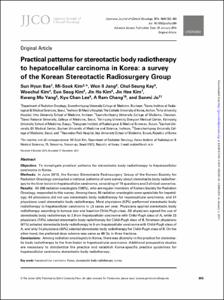KUMEL Repository
1. Journal Papers (연구논문)
1. School of Medicine (의과대학)
Dept. of Radiation Oncology (방사선종양학)
Practical patterns for stereotactic body radiotherapy to hepatocellular carcinoma in Korea: a survey of the Korean Stereotactic Radiosurgery Group
- Keimyung Author(s)
- Kim, Jin Hee
- Department
- Dept. of Radiation Oncology (방사선종양학)
- Journal Title
- Japanese Journal of Clinical Oncology
- Issued Date
- 2016
- Volume
- 46
- Issue
- 4
- Abstract
- Objective: To investigate practical patterns for stereotactic body radiotherapy to hepatocellular
carcinoma in Korea.
Methods: In June 2013, the Korean Stereotactic Radiosurgery Group of the Korean Society for
Radiation Oncology conducted a national patterns-of-care survey about stereotactic body radiotherapy
to the liver lesion in hepatocellular carcinoma, consisting of 19 questions and 2 clinical scenarios.
Results: All 208 radiation oncologists (100%), who are regular members of Korean Society for Radiation
Oncology, responded to this survey. Among these, 95 radiation oncologists were specialists for hepatology;
64 physicians did not use stereotactic body radiotherapy for hepatocellular carcinoma, and 31
physicians used stereotactic body radiotherapy. Most physicians (52%) performed stereotactic body
radiotherapy to hepatocellular carcinoma in ≤5 cases per year. Physicians applied stereotactic body
radiotherapy according to tumour size and baseline Child–Pugh class. All physicians agreed the use of
stereotactic body radiotherapy to 2.8-cm hepatocellular carcinoma with Child–Pugh class of A, while 23
physicians (74%) selected stereotactic body radiotherapy for Child–Pugh class of B. Nineteen physicians
(61%) selected stereotactic body radiotherapy to 5-cm hepatocellular carcinomawith Child–Pugh class of
A, and only 14 physicians (45%) selected stereotactic body radiotherapy for Child–Pugh class of B. On the
other hand, the preferred dose scheme was same as 60 Gy in three fractions.
Conclusions: Among radiation oncologists in Korea, therewas diversity in the practice for stereotactic
body radiotherapy to the liver lesion in hepatocellular carcinoma. Additional prospective studies
are necessary to standardize the practice and establish Korea-specific practice guidelines for
hepatocellular carcinoma stereotactic body radiotherapy.
- Keimyung Author(s)(Kor)
- 김진희
- Publisher
- School of Medicine
- Citation
- Sun Hyun Bae et al. (2016). Practical patterns for stereotactic body radiotherapy to hepatocellular carcinoma in Korea: a survey of the Korean Stereotactic Radiosurgery Group. Japanese Journal of Clinical Oncology, 46(4), 363–369. doi: 10.1093/jjco/hyv209
- Type
- Article
- ISSN
- 0368-2811
- Appears in Collections:
- 1. School of Medicine (의과대학) > Dept. of Radiation Oncology (방사선종양학)
- 파일 목록
-
-
Download
 oak-2016-0182.pdf
기타 데이터 / 402.3 kB / Adobe PDF
oak-2016-0182.pdf
기타 데이터 / 402.3 kB / Adobe PDF
-
Items in Repository are protected by copyright, with all rights reserved, unless otherwise indicated.